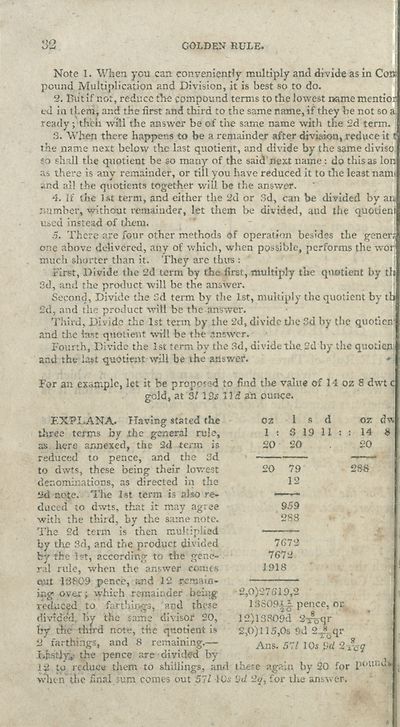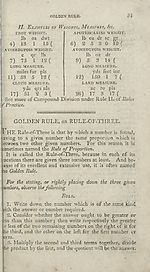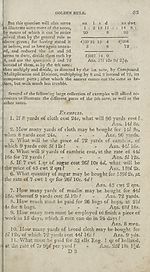Download files
Complete book:
Individual page:
Thumbnail gallery: Grid view | List view

32
GOLDEN RULE.
Note 1. When you can conveniently multiply and divide as in Com
pound Multiplication and Division, it is best so to do.
2. But if not, reduce the compound terms to the lowest name mentioc
ed in them, and the first and third to the same name, if they be not so aj
ready; then will the answer be of the same name with the 2d term.
S. 'When there happens to be a remainder after division, reduce it!
the name next below the last quotient, and divide by the same divisoj
so shall the quotient be so many of the saicl'next name: do this as Ion
as there is any remainder, or till you have reduced it to the least namt
and all the quotients together will be the answer.
4. If the 1st term, and either the 2d or Sd, can be divided by an|
number, without remainder, let them be divided, and the quotient
used instead of them.
5. There are four other methods Of operation besides the generi
one above delivered, any of which, when possible, performs the wor
much shorter than it. They arc thus :
First, Divide the 2d term by (he.first, multiply the quotient by th
3d, and the product will be the answer.
Second, Divide the 3d term by the 1st, multiply the quotient by th
2d, and the product will be the answer.
Third, Divide the 1st term by the 2d, divide the 3d by the quotienj
and the last quotient will be the answer.
Fourth, Divide the 1st term by the 3d, divide the. 2d by the quotieu)
and the last quotient will be the answer. *1
For an example, let it be proposed to find the value of 14 oz 8 dwt
gold, at 3/ 1 Ss 1 Id an ounce.
EXPDANA. Having stated the
three terms by the general rule,
as here annexed, the 2d term is
reduced to pence, and the 3d
to dwts, these being their lowest
denominations, as directed in the
2d note. The 1st term is also re-
duced to dwts, that it may agree
with the third, by the same note.
The 2d term is then multiplied
by the 3d, and the product divided
by the 1st, according to the gene¬
ral rule, when the answer comes
owt 13809 pence, and 12 remain¬
ing over; which remainder being
reduced to farthings, and these
(ry the third note, the quotient is
2 farthings, and 8 remaining.—
l.hstjyv the pence arc divided by .
12 to reduce them to shillings, and these again by 20 for pounds
when the final sum comes out 571 10s 9d 2y, for tire
-2,0)27619,2
13309i£ pence, or
12)13809d 2^0 r
2,0) 115,0s 9d 2-j^qr
Ans. 571 10s Sd 2 vCy
GOLDEN RULE.
Note 1. When you can conveniently multiply and divide as in Com
pound Multiplication and Division, it is best so to do.
2. But if not, reduce the compound terms to the lowest name mentioc
ed in them, and the first and third to the same name, if they be not so aj
ready; then will the answer be of the same name with the 2d term.
S. 'When there happens to be a remainder after division, reduce it!
the name next below the last quotient, and divide by the same divisoj
so shall the quotient be so many of the saicl'next name: do this as Ion
as there is any remainder, or till you have reduced it to the least namt
and all the quotients together will be the answer.
4. If the 1st term, and either the 2d or Sd, can be divided by an|
number, without remainder, let them be divided, and the quotient
used instead of them.
5. There are four other methods Of operation besides the generi
one above delivered, any of which, when possible, performs the wor
much shorter than it. They arc thus :
First, Divide the 2d term by (he.first, multiply the quotient by th
3d, and the product will be the answer.
Second, Divide the 3d term by the 1st, multiply the quotient by th
2d, and the product will be the answer.
Third, Divide the 1st term by the 2d, divide the 3d by the quotienj
and the last quotient will be the answer.
Fourth, Divide the 1st term by the 3d, divide the. 2d by the quotieu)
and the last quotient will be the answer. *1
For an example, let it be proposed to find the value of 14 oz 8 dwt
gold, at 3/ 1 Ss 1 Id an ounce.
EXPDANA. Having stated the
three terms by the general rule,
as here annexed, the 2d term is
reduced to pence, and the 3d
to dwts, these being their lowest
denominations, as directed in the
2d note. The 1st term is also re-
duced to dwts, that it may agree
with the third, by the same note.
The 2d term is then multiplied
by the 3d, and the product divided
by the 1st, according to the gene¬
ral rule, when the answer comes
owt 13809 pence, and 12 remain¬
ing over; which remainder being
reduced to farthings, and these
(ry the third note, the quotient is
2 farthings, and 8 remaining.—
l.hstjyv the pence arc divided by .
12 to reduce them to shillings, and these again by 20 for pounds
when the final sum comes out 571 10s 9d 2y, for tire
-2,0)27619,2
13309i£ pence, or
12)13809d 2^0 r
2,0) 115,0s 9d 2-j^qr
Ans. 571 10s Sd 2 vCy
Set display mode to:
![]() Universal Viewer |
Universal Viewer | ![]() Mirador |
Large image | Transcription
Mirador |
Large image | Transcription
| Antiquarian books of Scotland > Education > Complete treatise on practical arithmetic and book-keeping > (46) |
|---|
| Permanent URL | https://digital.nls.uk/114434122 |
|---|
| Description | Thousands of printed books from the Antiquarian Books of Scotland collection which dates from 1641 to the 1980s. The collection consists of 14,800 books which were published in Scotland or have a Scottish connection, e.g. through the author, printer or owner. Subjects covered include sport, education, diseases, adventure, occupations, Jacobites, politics and religion. Among the 29 languages represented are English, Gaelic, Italian, French, Russian and Swedish. |
|---|

